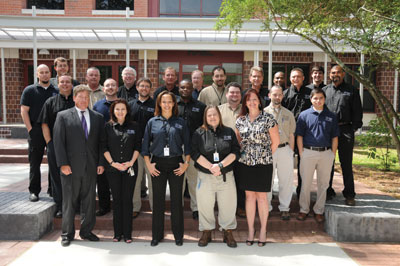Lone Star College System
It sounds very impressive: The six-campus Lone Star College System (TX), in the suburbs of Houston, has developed a sophisticated private cloud that offers greater flexibility, lower hardware costs, and improved performance. But CIO Link Alander has a confession to make: "We stumbled into the cloud," he admits.

The Technical Services team behind Lone Star College System's move to the cloud |
Alander and his IT team weren't thinking about the cloud back in 2009. They just wanted to improve computing performance for the system's 85,000 students. "Our technology was not reliable," he says. "Our ERP [enterprise resource planning] system could not handle the volume of students registering, and 60 percent of our data center hardware was end-of-life."
To solve these issues, Lone Star focused on server consolidation through virtualization, dynamic and flexible data storage, network load balancing, and federated identity management. "At the end of the first year we were 85 percent virtualized," Alander recalls.
It was only when they started to replace the ERP with a PeopleSoft system, however, that Alander and his team realized that they were creating a private cloud. "We were defining service levels for high availability with built-in virtualized storage," explains Alander. "We said to ourselves, 'Now that we have begun to build a private cloud, how can we maximize its utility?'"
With design help from eVolve Data Center Solutions, Lone Star set up two data centers 40 miles apart. Its resource pool features 172 physical CPUs and 1,350 virtual machine CPU cores. Lone Star estimates the move to a distributed cloud saved $1.4 million, taking into account the hardware, storage, and licensing costs.
Lone Star IT is now delivered (and paid for) as a service that's adjusted to meet the changing needs of the administration, faculty, and students. IT staffers no longer have to think about individual server performance or about individual campus networks, but instead can focus on systemwide capacity.
"We have elasticity and can expand during registration when demand is especially high and scale back other resources," Alander explains. By distributing virtual machines, the IT team discovered that it could turn on capacity and new virtual machines within minutes and hours instead of weeks or months. "The provisioning time change is light-years' difference," notes Alander.
Of course, changing from a system of application-specific servers required good communication and project-management skills--and some guts. Any political squabbling about the change was mitigated by the fact that Lone Star had already consolidated IT operations a few years earlier. Still, "This was uncharted water," Alander says. "We knew we were putting our necks on the line, but our technology services team and our enterprise application team both did great jobs."
The private cloud effort also involved coordinating the solutions provided by several key vendors, including:
- VMware's vCloud Director, which deploys workloads across shared infrastructure. Using this system, Lone Star is able to deploy new servers in less than a day, and services can be moved from location to location in the event of a hardware failure.
- Cisco's Unified Computing System data center management architecture
- EMC's data de-duplication and storage area networks
- HP's blade server hardware
"It was interesting to see companies that usually compete with each other, like HP and EMC, work together well," Alander says. "They really pulled together to meet our objectives on time."
During the transition from a physical to a virtual environment, Lone Star worked with systems integrator SHI, which also developed customized training for Lone Star staff. "It was important that all the pieces fit together," Alander says, "and that our staff understood well how it all works and how to troubleshoot it."
Moving to a private cloud has also necessitated investment in retraining. "The staff needs more than just technology training; they need to understand the organization's goals and how to add value," Alander says. "We have new job titles and descriptions and new skills--all around cloud computing."
Now that IT has been able to deliver "five nines," as Alander likes to say, in terms of ERP performance (99.999 percent uptime), it is earning a reputation for addressing business needs. That opens up new possibilities, including more online courses. Previously, Lone Star's online courses "didn't have the stability we needed," Alander says. "But since we have changed the way we deliver services, faculty and staff have gained more confidence and they in turn can offer more online courses."
Lone Star's next challenge is virtual desktops. "We are creating a virtual profile for each student and then dynamically provisioning just the software they need for their classes," Alander says. Delivering this software will require orchestrating a lot of moving pieces, both in the private and public cloud, as well as the ERP. Alander sees this project as even more exciting than the private cloud. "That project saved money and improved performance, but this will allow our students to do things they couldn't do before. This is providing real value for them."
| Lone Star College System's Link Alander and Oscar Ramos presented on the institution's latest application and desktop virtualization project at Campus Technology Forum, April 30 – May 2 in Long Beach, CA. Click here to view the recording of their session. |